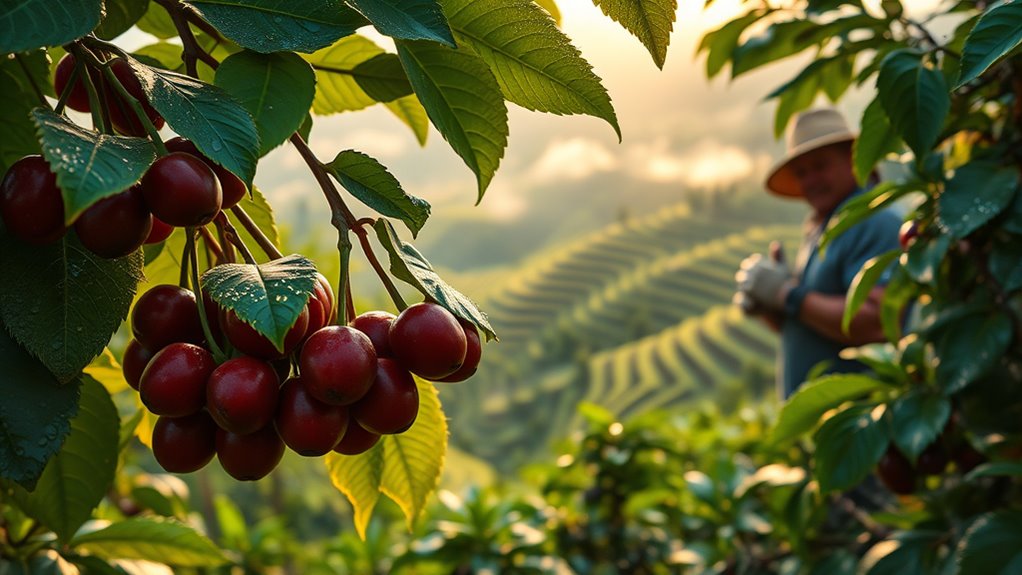Beyond the label, sustainable coffee faces real challenges like environmental impact, market instability, and fair labor practices. Climate change threatens crop yields, while fluctuating prices and limited access prevent farmers from thriving. Technology and certifications help guarantee transparency, but systemic reforms and equitable trade are essential for true sustainability. By understanding these hurdles, you can better appreciate how innovative solutions are shaping a more resilient coffee industry. Keep exploring to uncover how you can support meaningful change.
Key Takeaways
- Sustainable coffee faces environmental challenges like deforestation, greenhouse gas emissions, and climate change impacts on yield and plant health.
- Economic issues include fluctuating market prices, limited farmer income, and higher costs for organic and shade-grown varieties.
- Regulatory requirements, such as the EU Deforestation Regulation, demand transparency, compliance, and innovative tracking technologies.
- Fair trade principles and consumer awareness are vital for ensuring fair wages, stable income, and ethical sourcing practices.
- Technological solutions like IoT, blockchain, and satellite monitoring enhance transparency, resource management, and environmental conservation efforts.
The True Impact of Coffee’s Carbon Footprint

Have you ever wondered how much your morning coffee contributes to climate change? The answer lies mostly in the agricultural stage, where fertilizers, irrigation, and processing generate significant emissions. Conventional coffee production in countries like Brazil and Vietnam emits roughly 11.5 to 13 kg of CO₂e per kilogram of green coffee. A single espresso accounts for about 0.28 kg of CO₂e, but sustainable methods can reduce this to just 0.06 kg. Deforestation caused by coffee farming makes up around 5% of global deforestation rates, mainly through land use change and soil management. Nitrous oxide emissions from fertilizer use are especially potent, 265 times stronger than CO₂. These factors highlight how coffee farming impacts the environment, emphasizing the importance of sustainable practices to lessen its carbon footprint. Incorporating farmhouse kitchen textiles and accessories into eco-friendly coffee setups can further promote sustainability and aesthetic appeal. Additionally, adopting sustainable farming techniques can significantly reduce harmful emissions associated with coffee cultivation, and implementing soil conservation methods can help preserve land quality and reduce erosion. For example, cover cropping is an effective soil conservation practice that helps maintain soil health and reduce erosion. Moreover, understanding the carbon footprint of coffee can motivate consumers to choose more eco-friendly options and support sustainable producers.
Economic Hurdles for Farmers and Producers

While sustainable coffee farming offers environmental benefits, it also presents significant economic challenges for farmers and producers. Market prices for green coffee can fluctuate wildly, sometimes dropping below production costs, which threatens their income and sustainability. Farmers often depend heavily on coffee, limiting diversification and increasing financial vulnerability. Small-scale farmers frequently face poverty and debt, making it hard to invest in sustainable practices. Labor shortages can cut into productivity and profits, while limited infrastructure raises operational costs. Additionally, sustainable methods like shade-grown or organic coffee often lead to lower yields initially and higher production costs. Longer time to maturity and inconsistent premium payments further complicate profitability. To survive, farmers need better market access, fair prices, and support systems that address these economic hurdles. Furthermore, merchant services can play a critical role in providing reliable payment solutions and financial tools to help farmers manage their income more effectively.
Climate Change and Its Effect on Coffee Cultivation

Climate change poses a direct threat to coffee cultivation by altering the environmental conditions necessary for healthy growth. Rising temperatures and unpredictable rainfall patterns reduce yields and harm plant health. Extreme heat can damage coffee plants, while droughts and floods disrupt flowering and fruiting cycles. Elevated CO2 levels can influence growth but also increase disease susceptibility, such as fungal infections like coffee leaf rust. As the IPCC predicts a shrinking area suitable for coffee by 2050, farmers face declining productivity and income. Small-scale farmers, in particular, struggle to adapt due to limited resources and increased vulnerability. To combat these impacts, adopting resilient coffee varieties, diversifying crops, and implementing sustainable practices are essential steps toward safeguarding coffee cultivation in a changing climate. Climate-resilient techniques are increasingly being explored to help farmers adapt to these challenges.
Navigating Environmental Regulations and Deforestation Laws

Managing environmental regulations and deforestation laws is essential for coffee exporters aiming to access key markets like the European Union. The EU’s Deforestation Regulation (EUDR) mandates that your supply chain be deforestation-free by 2025. You’ll need to report compliance regularly, or risk losing market access. Sustainability certifications like Rainforest Alliance can help demonstrate adherence to environmental standards, but you must also implement risk evaluation mechanisms to identify and reduce deforestation risks. Enforcing sustainable practices, such as agroforestry and shade-grown coffee, is vital. While these practices may increase costs, they open doors to premium prices and consumer trust. Investing in digital monitoring tools and blockchain technology can streamline compliance, ensuring transparency and making it easier to meet evolving regulations. Additionally, engaging with live music and cultural performances at local restaurants can foster community support and promote awareness of sustainable initiatives. Incorporating self-watering plant pots into community projects or educational programs can also serve as a practical example of sustainable resource management and environmental consciousness.
Social Justice and Fair Labor Practices in Coffee Supply Chains

Addressing environmental compliance is only part of building a sustainable coffee supply chain; ensuring fair labor practices and social justice are equally important. You need to recognize that workers across the supply chain—pickers, processors, and café staff—often face exploitation, informal work, and systemic gender inequalities. Certification systems like Fair Trade establish minimum prices and social premiums to support farmers and communities, but their reach is limited by costs and bureaucracy. Solutions like third-party audits, codes of conduct, and transparency efforts—such as blockchain—help enforce fair wages and safe working conditions. Empowerment through education and training boosts farmers’ skills and leadership, especially for women. Additionally, high input lag levels in some projectors can hinder the responsiveness needed for real-time applications, emphasizing the importance of choosing the right technology. Ultimately, consumer demand, activism, and corporate accountability drive progress toward a fairer, more just coffee industry. Recognizing the importance of social justice and fair labor practices is essential for creating meaningful change in the industry.
Addressing Market Instability and Price Fluctuations

Market instability and price fluctuations pose significant threats to the sustainability of coffee production, especially for smallholder farmers who operate on narrow profit margins. When prices drop, farmers struggle to cover costs, limiting access to essentials like education, healthcare, and housing. Geographical isolation increases costs for transportation and tools during downturns, worsening financial strain. Climate change adds unpredictability through irregular harvests and rising production expenses. Rising input costs, like fertilizer and labor, outpace stagnant farmgate prices, squeezing small producers further. Without effective price mechanisms that account for environmental and social costs, farmers face ongoing economic vulnerability. Implementing innovative flushing mechanisms and water-efficient designs can help reduce operational costs and environmental impacts. Additionally, establishing transparent pricing systems can improve income stability for farmers. Market volatility further exacerbates farmers’ difficulties in planning and investing in sustainable practices. Developing alternative pricing strategies that incorporate environmental and social considerations can promote resilience. Furthermore, adopting technological advancements such as digital platforms can enhance market access and price transparency for small-scale farmers. To stabilize markets, systemic reforms, better price-setting strategies, and fair trade policies are essential.
Leveraging Technology and Certification for Better Sustainability

Advances in technology and certification systems are transforming how coffee producers achieve sustainability. IoT sensors monitor soil moisture, temperature, and nutrients, allowing you to optimize irrigation and fertilization. Satellite tracking helps identify deforestation risks and measure carbon sequestration, supporting eco-friendly practices. AI-driven disease detection enables early pest identification, reducing chemical use. Automated shading systems improve bean quality and promote biodiversity, while water-efficient drip irrigation cuts water consumption by up to 50%. Blockchain enhances supply chain transparency, verifying ethical sourcing through immutable records and automating payments with smart contracts. It also allows consumers to access farm-level sustainability data via QR codes. These innovations reduce costs, improve compliance, and boost consumer trust, making sustainable coffee more accessible and verifiable for producers of all sizes. Incorporating sustainable farming practices can further enhance environmental benefits and long-term viability. Additionally, employing advanced monitoring technologies can help identify potential issues early, leading to more proactive management and better resource utilization. Integrating real-time data analysis ensures continuous improvement and responsiveness to changing environmental conditions.
Building Equitable Trade Relationships and Long-Term Partnerships

Building equitable trade relationships and long-term partnerships is essential for creating a sustainable coffee industry that benefits all stakeholders. By embracing fair trade principles, you guarantee producers receive a guaranteed minimum price, providing income stability despite market fluctuations. Direct trade practices eliminate middlemen, often increasing farmers’ earnings by up to 25%, and foster trust through mutual respect. These partnerships support joint sustainability efforts, sharing knowledge about environmentally friendly practices and improving community well-being with premiums funding education and healthcare. Transparent supply chains strengthen traceability, connecting consumers directly to the origin. Collaborating closely with farmers and roasters creates a resilient network that promotes fairness, environmental conservation, and social equity—building a foundation for a truly sustainable coffee industry. Additionally, establishing clear supply chain processes ensures accountability and enhances consumer confidence. Incorporating hybrid approaches in supply chain management can further streamline operations and improve adaptability in fluctuating markets. Moreover, fostering an environment that encourages creative problem-solving helps address complex challenges in supply chain logistics and sustainability initiatives. Recognizing the importance of health benefits associated with sustainable practices can motivate stakeholders to prioritize ecological and social well-being throughout the supply chain. Understanding the role of certifications and standards can also bolster trust and verification in sustainable coffee practices.
Engaging Consumers in Sustainable Coffee Choices

Engaging consumers in sustainable coffee choices is essential for driving industry change and promoting environmentally and socially responsible practices. When you choose certified coffees like Organic, Fair Trade, or Rainforest Alliance, you support ethical sourcing and conservation efforts. With 70% of global consumers influenced by eco-friendly claims, your purchasing decisions carry significant weight. By prioritizing sustainable options, you help reduce deforestation, conserve water, and promote fair wages for farmers. Supporting local coffee shops that focus on ethical sourcing amplifies this impact. Industry responses show that companies are increasingly offering sustainable products due to consumer demand. Your awareness and choices directly influence the market, encouraging more transparent, eco-conscious practices and fostering a global shift toward sustainability in the coffee industry. Additionally, understanding Fokos can help consumers make more informed choices about the sources and practices behind their coffee. Recognizing the importance of ethical sourcing can further empower consumers to select truly sustainable options and support brands committed to positive social and environmental impact. Being aware of sustainable certifications can also guide consumers toward more reputable products and ensure their purchases align with their values.
Frequently Asked Questions
How Do Small Farmers Access Sustainable Coffee Certifications Easily?
You want to know how small farmers can access sustainable coffee certifications easily. To do so, you should explore programs that reduce upfront costs, like grants or subsidies, and seek training to understand certification standards better. Joining cooperatives can help share expenses and strengthen bargaining power. Connecting with local organizations or NGOs that offer support and simplified processes also makes certification more accessible, increasing your chances of success.
What Are the Real Costs of Implementing Eco-Friendly Farming Practices?
Imagine planting a garden that flourishes with eco-friendly care—initially, you face higher costs like organic fertilizers, renewable energy setups, and labor for pest control. You’ll also spend time training workers and maintaining shade trees. While the upfront investment feels steep, over time, healthier soil, better yields, and access to niche markets can make your garden truly sustainable. Just remember, patience and persistence turn small efforts into long-lasting growth.
How Can Governments Better Support Sustainable Coffee Initiatives?
You can better support sustainable coffee initiatives by creating strong policy frameworks that encourage eco-friendly practices. Offer incentives like subsidies or tax breaks to motivate farmers, and provide training on regenerative techniques. Foster public-private partnerships for funding, set clear regulatory standards, and develop certification schemes. Additionally, invest in agroforestry projects, climate resilience, and awareness campaigns to build a sustainable coffee industry that benefits farmers, consumers, and the environment.
What Role Do Consumers Play in Reducing Coffee’S Environmental Impact?
You play a crucial role in reducing coffee’s environmental impact by making mindful choices. Opt for certified sustainable coffee, choose energy-efficient brewing methods, and support brands transparent about emissions. Be diligent about waste reduction through composting grounds and recycling packaging. Educate others about sustainable practices, advocate for stronger policies, and demand transparency from brands. Your decisions directly influence the market, encouraging more sustainable farming, production, and consumption habits worldwide.
How Can Supply Chains Be Made More Transparent and Equitable?
Think of the supply chain as a web, and you can help make it stronger and clearer. You can demand transparency by choosing brands that share detailed sourcing info and support fair practices. Encourage technology use like blockchain, which keeps everything honest. Your voice matters—by supporting ethical companies, you help create a more equitable system where farmers get fair prices, and environmental impacts are minimized. Your choices shape the future of sustainable coffee.
Conclusion
As you explore the world of coffee, remember that every sip has a story behind it. By choosing thoughtfully, supporting fair practices, and staying curious, you help turn the tide toward sustainability. Your mindful choices can gently influence positive change, making the coffee journey kinder for farmers, the planet, and future brew lovers. Together, we can enjoy our favorite cup while nurturing a healthier, more vibrant coffee community for all.









